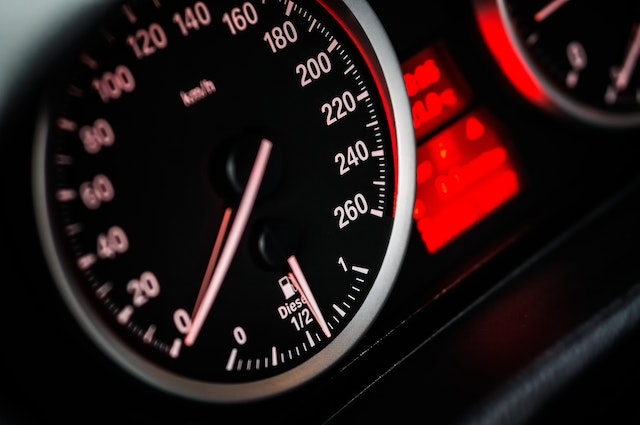
How does a speedometer work? By translating the speed of the wheel’s rotation into a magnetic field.
These days, electronic speedometers are becoming more common, but mechanical ones are still the norm. Let’s look at mechanical ones first. The mechanical speedometer has a dial that sits in the dashboard and miles or kilometers around the outside. As you accelerate, a needle moves around the dial, indicating your speed. They are accurate enough, but not 100% accurate because the amount of air in the tires, and a whole host of other factors can cause them to read incorrectly. They are rated to be accurate to 10% of the car’s speed plus 4 km per hour.
So, how do they work? To gauge the speed of a car at any one moment, it is not necessary to know how fast the wheels are spinning. It is all done through a magnetic field. The speedometer is connected by a long, flexible drive cable to the car’s transmission shaft. The transmission shaft is the part of the car that transfers the spinning movement from the engine’s crankshaft to the wheels. The more power sent to the wheels, the faster this spins. The speedometer is connected before the gearbox so that the rate of spin isn’t affected by what gear the car is in.
The speedometer is connected by a long and flexible cable, which is called a mandrel. It has a lot of small springs tightly wound around a central wire. The cable is connected via gears that turn the transmission’s horizontal spin into vertical spin in the wire. The wire in the center of the cable can spin freely within the springs and it rotates at the same speed as the transmission.
At the other end, the cable is connected to a magnet at the back of the speedometer. The speedometer is shaped like a metal cup and is called the speedcup. The part we can see, with the dial and the needle, is the front of the cup and the cable from the transmission connects to a magnet at the back of the cup. There is a slight space so that the magnet and the speedcup are not touching. The needle on the dial we can see is connected directly to the speedcup, while the dial is set in the dashboard. The speedcup is connected to a hairspring.
When the transmission rotates, the cable rotates, and that makes the magnet in the speedcup rotate. The spinning magnet creates a rotating magnetic field and a small electrical current. The speedcup is attracted to the magnet and moves in the direction of the magnetic field. The hairspring pulls against the speedcup and stops it moving very far. As the transmission speeds up and the cable and the magnet spin faster, the strength of the magnetic field increases, pulling the speed cup more. The hairspring pulls against the speedcup, but it is able to move further because of the magnetic field. As the speedcup moves round, the needle on the dial we can see moves round. When the transmission slows down, the magnetic field reduces and the hairspring pulls the needle back. And that’s how a mechanical speedometer works.
How does a digital speedometer work? Mechanical speedometers are reliable, but they have a lot of moving parts that can break. Digital speedometers are simpler. Small magnets are attached to the driveshaft. As the driveshaft spins, these magnets pass a sensor and they generate a very quick electric current. The sensor reads this and counts how many times the electric pulses come. It knows the distance between each magnet, so by counting how quickly the magnets are moving, it can calculate the car’s speed. This is then sent to the readout.
Both mechanical and digital speedometers are also able to work out how far the car has travelled. The milometer is always located in the same place as the speedometer, and this is because the distance is calculated from the same device that the speed is calculated from. In a mechanical speedometer, the milometer is connected to the cable from the transmission by a gear. The milometer is calibrated so that x number of spins of the cable make the first digit of the milometer move. Then the milometer digits are all connected by simple gears so that 10 spins of the first digit make the second digit move one, and so on. A digital speedometer knows how far the magnets are moving and the computer in the car can calculate the distance very easily.
The mechanical speedometer system that we use today was invented by Otto Schulze, a German engineer, in 1902. Most cars couldn’t go very fast in those days, but car improvements and speed improvements both came along pretty quickly. And this is what I learned today.
Sources
https://protectmycar.com/blog/how-speedometer-work
https://www.howacarworks.com/accessories/how-a-speedo-works
